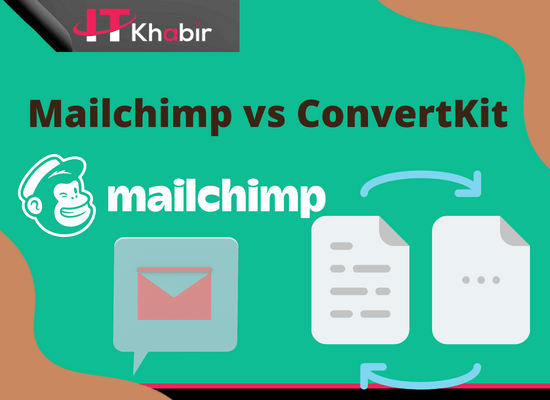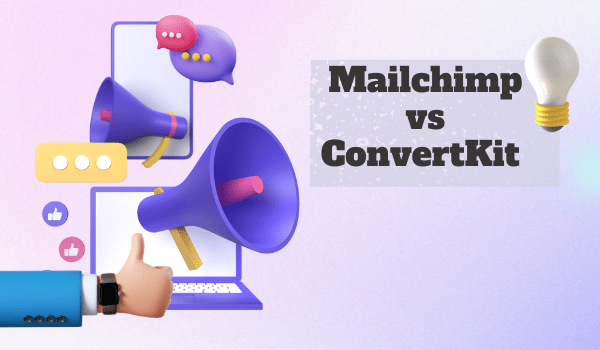Mailchimp and ConvertKit are two of the most popular email marketing platforms. They both offer a wide range of features and are used by many businesses of all sizes.
Mailchimp is a more traditional email marketing platform, with a wide range of features and a fairly simple interface. ConvertKit, on the other hand, is a newer platform that is designed specifically for online creators and bloggers. It offers a more modern interface and a range of features that are tailored for this audience.
So, which platform is right for you? It depends on your needs and preferences. If you are looking for a more traditional email marketing platform with a wide range of features, Mailchimp is a good option. If you are an online creator or blogger, ConvertKit may be a better fit for you.
- Watch now Digital product lifetime deal 97% Off
Mailchimp vs ConvertKit
Mailchimp
Mailchimp is a tool that allows businesses to create and send newsletters, emails, and other automated messages. It is one of the most popular email marketing platforms on the market, and for good reason – it is easy to use, has a wide range of features, and is very affordable.
Mailchimp is one of the most popular email marketing platforms out there. And for good reason – it’s easy to use, has a ton of features, and is affordable.
But what exactly is Mailchimp? In this article, we’ll give you a rundown of everything you need to know about Mailchimp, including what it is, how it works, and why you should be using it for your email marketing.
What is Mailchimp?
Mailchimp is an email marketing platform that allows you to send newsletters, automated emails, and targeted campaigns to your subscribers. You can use Mailchimp to stay in touch with your customers, promote your products or services, or simply share your latest news.
How does Mailchimp work?
Mailchimp works by allowing you to create email campaigns that are sent to your subscribers. You can create a campaign from scratch, or use one of Mailchimp’s pre-made templates.
Once you’ve created your campaign, you can add your own content, images, and links. You can also choose when and how often you want your campaign to be sent.
Why should I use Mailchimp?
There are a few reasons why you should use Mailchimp for your email marketing. First, it’s easy to use. You can create a campaign in minutes, even if you’ve never sent an email before.
Second, Mailchimp is affordable. You can start sending emails for free, with no commitment. And if you need more features, you can upgrade to a paid plan that fits your budget.
Finally, Mailchimp is effective. With features like automation and targeted campaigns, you can make sure your emails are being seen by the right people and that they’re taking action.
Ready to get started with Mailchimp?
If you’re ready to start using Mailchimp for your email marketing, sign up for a free account today.
1. Mailchimp Pricing
Mailchimp is one of the most popular email marketing platforms on the market. And for good reason: it’s easy to use, has a ton of features, and it’s affordable.
The Mailchimp pricing plans start at $10/month for the Basic plan, which includes up to 2,000 contacts and 10,000 sends per month. From there, the plans increase in cost as you add more features and contacts. The next tier is the Standard plan, which includes all of the features in the Basic plan plus some extras, like advanced reporting and automated emails. This plan starts at $15/month for up to 500 contacts.
If you need more than 500 contacts, you’ll need to sign up for a Mailchimp Pro plan. These plans start at $199/month and include all of the features in the Standard plan plus some extras, like free phone support and a dedicated IP address.
Here’s a breakdown of all the features included in each Mailchimp pricing plan:
Basic
- Up to 2,000 contacts
- 10,000 sends per month
Standard
- All of the features in the Basic plan, plus:
- Advanced reporting
- Automated emails
Pro
- All of the features in the Standard plan, plus:
- Free phone support
- Dedicated IP address
There are also some add-ons that you can purchase separately, like Mailchimp Expert Services, which start at $149/month.
Overall, Mailchimp is a great value for the price. If you’re just starting out with email marketing, the Basic plan is a great way to get started. And as your needs grow, you can upgrade to a more expensive plan.
2. Email Templates
We often hear about the importance of email list building, but what happens once you have a sizable list? How do you keep people engaged?
One way to keep your list engaged is by using Mailchimp email templates. Mailchimp is a great tool for managing email lists and creating beautiful email newsletters.
There are a variety of Mailchimp email templates to choose from, so you can find the perfect one for your business. And, if you need help creating a custom template, Mailchimp’s team of experts can assist you.
Once you have a template that you love, it’s time to start using it! Here are a few tips for using Mailchimp email templates:
1. Use Mailchimp’s drag-and-drop email builder to easily customize your template.
2. Add your branding to the template by including your logo and colors.
3. Use engaging images and videos to make your email more visually appealing.
4. Use Mailchimp’s automation features to send your email at the perfect time.
5. Use Mailchimp’s reporting tools to track the performance of your email.
By following these tips, you can use Mailchimp email templates to create beautiful, engaging emails that will keep your list engaged. So, what are you waiting for? Get started today!
3. Mailchimp Send Time Optimization.
When it comes to email marketing, timing is everything. Send your emails at the wrong time, and you’ll likely see low open and click-through rates. But send them at the perfect time, and you could see a significant boost in engagement.
That’s where send time optimization comes in. Send time optimization is the process of finding the best time to send your emails, based on your subscribers’ engagement patterns.
There are a few different ways to go about send time optimization. You can either do it manually, by analyzing your subscribers’ engagement data and making adjustments to your send times accordingly, or you can use an automated tool that will do the heavy lifting for you.
If you’re just getting started with send time optimization, we recommend using an automated tool. That way, you can focus on other aspects of your email marketing strategy and let the tool do the work of finding the best send times for your subscribers.
Once you’ve found the perfect send time for your subscribers, be sure to test and adjust as needed. Subscribers’ engagement patterns can change over time, so it’s important to keep an eye on your open and click-through rates and make changes to your send times as needed.
Happy send time optimizing!
4. Mailchimp Ease of Use
If you’re looking for an email marketing service that’s easy to use, you can’t go wrong with Mailchimp. Mailchimp has a user-friendly interface that makes it easy to create and send newsletters, email campaigns, and other marketing materials. And if you need any help, Mailchimp’s extensive online support resources are always available.
ConvertKit
ConvertKit is an email marketing tool that helps you build a list of subscribers and send them automated emails. It’s designed for online creators, like bloggers, podcasters, and YouTubers, who want to grow their audience and make more money.
In this ConvertKit review, we’ll take a look at the features that make it a good choice for online creators, as well as some of the drawbacks. We’ll also give you an overview of the pricing and show you how ConvertKit compares to similar email marketing tools.
1. ConvertKit Pricing
ConvertKit is one of the most popular email marketing platforms on the market today. They offer a wide range of features and have a very user-friendly interface. One of the things that makes ConvertKit so popular is their pricing structure.
ConvertKit offers a tiered pricing structure that is based on the number of subscribers you have. The more subscribers you have, the higher your monthly price will be. However, they do offer a discount if you pay for a year in advance.
The lowest tier starts at $29/month for up to 1,000 subscribers. The next tier is $49/month for up to 3,000 subscribers. After that, it jumps to $79/month for up to 5,000 subscribers. The highest tier is $119/month for up to 10,000 subscribers.
As you can see, the pricing is very reasonable. But what if you have more than 10,000 subscribers? Don’t worry, ConvertKit has you covered. They offer a custom plan that starts at $199/month for up to 25,000 subscribers. If you need more than that, they will work with you to create a custom plan that meets your needs.
Overall, ConvertKit is a great option for those looking for a quality email marketing platform. Their pricing is very reasonable and they offer a wide range of features.
2. Email ConvertKit
The Email Marketing Checklist for Success
As an email marketing expert, I often get asked by clients, “What are the most important things I need to do to succeed with email marketing?”
While there are many factors that contribute to a successful email marketing campaign, I’ve compiled a list of the most important things to keep in mind, whether you’re just getting started or you’re a seasoned pro.
1. Define your goals
Before you even start planning your email marketing campaign, you need to know what you want to achieve. Are you looking to increase brand awareness, drive traffic to your website, or generate sales?
Once you know your goal, you can start to plan your email marketing strategy accordingly. If you’re not sure where to start, our Email Marketing 101 guide can help.
2. Build your list
Your email list is one of the most important assets you have when it comes to email marketing. Without a list of subscribers, you won’t be able to send out emails, let alone achieve your goals.
There are a few different ways to build your list, but the most important thing is to make sure you’re only adding subscribers who are interested in hearing from you. No one wants to receive emails they didn’t sign up for, so make sure you’re clear about what they can expect from you before they subscribe.
3. Create great content
Now that you have a list of subscribers, it’s time to start creating content that will engage and convert them. Whether you’re writing blog posts, creating graphics, or filming videos, your goal should always be to create content that’s helpful and relevant to your audience.
If you’re not sure where to start, take a look at our Email Marketing Content Ideas guide for some inspiration.
4. Send targeted emails
With your goals and content in hand, you’re ready to start sending out emails. But before you hit “send,” take a moment to segment your list so you’re only sending targeted emails to those who will find them most relevant.
For example, if you sell men’s and women’s clothing, you wouldn’t want to send the same email to both lists. Instead, you’d want to segment your list and send different emails to each, based on their interests.
Not sure how to segment your list? Our guide to email list segmentation can help.
5. Test, test, test
Before you launch your email marketing campaign, it’s important to test everything to make sure it’s working properly. This includes testing your subject lines, email content, calls to action, and more.
It’s also important to test different versions of your emails to see what works best with your audience. For example, you might want to test sending emails on different days of the week or at different times of the day.
Our guide to email marketing testing can help you get started.
6. Measure your results
Once your email marketing campaign is up and running, it’s important to track your results so you can see what’s working and what’s not. There are a number of different metrics you can track, but some of the most important include open rate, click-through rate, and unsubscribe rate.
You can also use Google Analytics to track how much traffic your emails are driving to your website. Our guide to email marketing metrics can help you get started.
By following these six steps, you can set your email marketing campaign up for success.
3. ConvertKit Send Time Optimization.
If you’re like most people, you probably spend a lot of time wondering when is the best time to send your email newsletter.
After all, you want to make sure that your message is seen by as many people as possible, and that means sending it at a time when people are most likely to be checking their email.
Luckily, there’s a tool that can help you figure out the best time to send your emails: ConvertKit’s Send Time Optimization.
Here’s how it works:
1. ConvertKit analyzes your email list to see when people are most likely to open your emails.
2. Based on that data, ConvertKit recommends the best time for you to send your emails.
3. You can then choose to either send your emails at the recommended time, or you can manually select a time that works better for you.
4. ConvertKit will continue to analyze your email list and adjust the recommended send time as needed.
Using ConvertKit’s Send Time Optimization is a great way to make sure that your emails are being seen by as many people as possible. So if you’re looking for a way to get more people to read your emails, give ConvertKit’s Send Time Optimization a try.
4. ConvertKit Ease of Use
ConvertKit is one of the easiest to use email marketing platforms on the market today. With its simple interface and powerful automation features, ConvertKit makes it easy to get started with email marketing and quickly start seeing results.
ConvertKit’s interface is designed to be intuitive and easy to use. With just a few clicks, you can add subscribers, create email campaigns, and automate your email marketing. ConvertKit also makes it easy to segment your subscribers and target your campaigns, so you can send the most relevant and targeted emails to your list.
ConvertKit’s automation features are some of the most powerful on the market. With ConvertKit, you can quickly and easily create automated email sequences that engage and convert your subscribers. You can also add powerful triggers to your sequences so that they send at just the right time.
All of these features make ConvertKit an incredibly powerful email marketing platform. But the best part is that it’s easy to use, so you can get started quickly and see results fast.
What Mailchimp is used for?
Mailchimp is an email marketing service that allows businesses to send out newsletters, promotional materials, and other communications to their customers. It is one of the most popular email marketing services on the market, and it offers a wide range of features and integrations that make it a versatile tool for businesses of all sizes.
Is Mailchimp free to use?
Mailchimp is a popular email marketing service that offers both a free and paid plan. The free plan includes all of the basic features needed to create and send newsletters, including Mailchimp’s email templates, signup forms, and reporting tools. Paid plans start at $10 per month and include additional features such as automation and advanced reporting.
What is ConvertKit used for?
ConvertKit is a powerful email marketing software that helps you build relationships with your subscribers and grow your business. With ConvertKit, you can easily create and send beautiful email newsletters, automated email sequences, and targeted email courses to your subscribers. ConvertKit also makes it easy to manage your subscribers and track your email marketing results.
Is ConvertKit same as MailChimp?
Whether you are a blogger, YouTuber, or Instagram influencer, you want to make sure you are using the best email marketing service for your business. Two of the most popular email marketing services are ConvertKit and MailChimp. While they both offer similar services, there are some key differences that you should take into account when deciding which one to use.
One of the biggest differences between ConvertKit and MailChimp is the price. ConvertKit charges a monthly fee based on the number of subscribers you have while MailChimp charges a monthly fee based on the number of emails you send. This can make a big difference if you are just starting out and don’t have a lot of subscribers.
Another difference is the automation features offered by each service. ConvertKit offers more automation options than MailChimp, which can be a big advantage if you want to save time by automate your email marketing.
Finally, ConvertKit offers a more intuitive and user-friendly interface than MailChimp. This can be a big advantage if you are not tech-savvy or if you want an easy-to-use email marketing service.
So, which email marketing service is right for you? It really depends on your needs and budget. If you are just starting out, MailChimp might be a better option because it is cheaper. If you want more automation and a user-friendly interface, ConvertKit might be a better option.
Related Articles
- Onlinecoursehost Review – Best Online Course Platforms That You’ll Love
- Oode Lifetime Deal – Is A Best Business Management Platform.
Mailchimp vs ConvertKit: Final Thought
There is no clear winner when it comes to Mailchimp vs ConvertKit. Both email marketing platforms have their pros and cons, so it really depends on what your specific needs are. If you need a more user-friendly interface, Mailchimp might be the better choice. However, if you need more robust automation features, ConvertKit could be a better fit. Ultimately, it’s up to you to decide which platform is best for your business.
- Watch now Digital product lifetime deal 97% Off

















